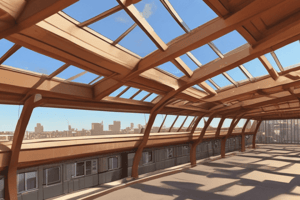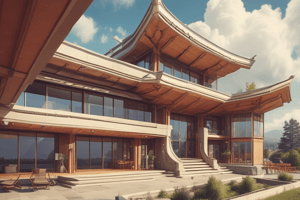Podcast
Questions and Answers
What is a characteristic of a gable roof?
What is a characteristic of a gable roof?
- Four sloping sides that meet at the top
- Two sloping sides that meet at a ridge in the middle (correct)
- A single sloping surface
- A horizontal or slightly pitched surface
Which type of roof is more stable than a gable roof?
Which type of roof is more stable than a gable roof?
- Hip roof (correct)
- Shed roof
- Flat roof
- Gable roof
What is a benefit of a flat roof?
What is a benefit of a flat roof?
- Is more stable than a hip roof
- Provides more headroom and storage space
- Offers excellent protection from wind and weather
- Can be used for outdoor living spaces or gardens (correct)
What is a characteristic of a gambrel roof?
What is a characteristic of a gambrel roof?
What is a consideration in roof design for areas with heavy snowfall?
What is a consideration in roof design for areas with heavy snowfall?
Why is it important to consider the building's style and aesthetic in roof design?
Why is it important to consider the building's style and aesthetic in roof design?
What is a benefit of a mansard roof?
What is a benefit of a mansard roof?
What is an important consideration in roof design to ensure safety?
What is an important consideration in roof design to ensure safety?
Flashcards are hidden until you start studying
Study Notes
Types of Roof Designs
1. Gable Roof
- Simple and classic design
- Two sloping sides that meet at a ridge in the middle
- Can be used on various types of buildings
2. Hip Roof
- Four sloping sides that meet at the top
- More stable than gable roofs
- Provides excellent protection from wind and weather
3. Flat Roof
- Horizontal or slightly pitched surface
- Often used on modern and industrial-style buildings
- Can be used for outdoor living spaces or gardens
4. Shed Roof
- Single sloping surface
- Often used on modern and minimalist-style buildings
- Provides a clean and simple aesthetic
5. Gambrel Roof
- Two slopes on each side, with the lower slope being steeper
- Provides more headroom and storage space
- Often used on barns and colonial-style buildings
6. Mansard Roof
- Four slopes on each side, with the lower slope being steeper
- Provides extra living space and storage
- Often used on historic and ornate-style buildings
7. Skillion Roof
- Single sloping surface, often used on modern and minimalist-style buildings
- Provides a clean and simple aesthetic
- Can be used on sheds, garages, and other small structures
Factors to Consider in Roof Design
- Climate: Design should consider local weather patterns, such as heavy snowfall or high winds.
- Architecture: Roof design should complement the building's style and aesthetic.
- Functionality: Design should consider the building's purpose and intended use.
- Budget: Design should consider the cost of materials and construction.
- Local Building Codes: Design should comply with local building codes and regulations.
Types of Roof Designs
- Gable roofs feature a simple and classic design with two sloping sides that meet at a ridge in the middle, suitable for various types of buildings.
- Hip roofs have four sloping sides that meet at the top, offering more stability and excellent protection from wind and weather.
- Flat roofs have a horizontal or slightly pitched surface, often used on modern and industrial-style buildings, and can be used for outdoor living spaces or gardens.
- Shed roofs have a single sloping surface, providing a clean and simple aesthetic, and are often used on modern and minimalist-style buildings.
- Gambrel roofs have two slopes on each side, with the lower slope being steeper, providing more headroom and storage space, often used on barns and colonial-style buildings.
- Mansard roofs have four slopes on each side, with the lower slope being steeper, providing extra living space and storage, often used on historic and ornate-style buildings.
- Skillion roofs have a single sloping surface, often used on modern and minimalist-style buildings, providing a clean and simple aesthetic, and can be used on sheds, garages, and other small structures.
Factors to Consider in Roof Design
Climate Considerations
- Roof design should consider local weather patterns, such as heavy snowfall or high winds.
Architectural Considerations
- Roof design should complement the building's style and aesthetic.
Functional Considerations
- Roof design should consider the building's purpose and intended use.
Budget Considerations
- Roof design should consider the cost of materials and construction.
Regulatory Considerations
- Roof design should comply with local building codes and regulations.
Studying That Suits You
Use AI to generate personalized quizzes and flashcards to suit your learning preferences.




